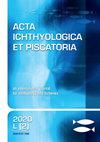Alteration of the feeding behavior of an omnivorous fish, Scardinius acarnanicus (Actinopterygii: Cypriniformes: Cyprinidae), in the presence of fishing lights
IF 0.8
4区 农林科学
Q3 FISHERIES
引用次数: 3
Abstract
Fishing with light is an old and common practice yielding a substantial catch volume globally. Despite the popularity of the method and the efforts to improve it, there is a lack of field studies on the effects of light on the feeding preferences of the attracted fishes. A previous report suggested that purse seine fishing lights can differentiate the feeding preferences of the approaching fishes, such as Atherina boyeri Risso, 1810 in Lake Trichonis (Greece). The presently reported study aims to verify these findings by investigating the diet of the endemic Scardinius acarnanicus Economidis, 1991. The feeding behavior of S. acarnanicus was studied from 2016 to 2019 through gut content analysis, in specimens from Lake Trichonis that came from purse seining with light and specimens caught without light. The same investigation was carried out comparatively in specimens taken by gillnets from two nearby lakes (lakes Ozeros and Amvrakia), where S. acarnanicus is present, but no fishing with light is exercised. The stomach content analysis conducted on 699 S. acarnanicus specimens revealed the intense effect of light on its diet resulting in the alteration of its feeding habits towards fish predation and especially Atherina boyeri. On the contrary, the specimens taken with the use of gillnets, from the three lakes, showed a typical omnivorous feeding behavior. The findings of the presently reported study support the assumption that the elevated concentration of fish close to fishing lights alters the feeding behavior of certain species making them predators. Considering that fishing with light is practiced worldwide, this could be of great ecological significance to the ichthyofauna not only of inland waters but also of marine areas, affecting perhaps several commercial species.鱼灯照射下杂食性鱼cardinius carnanicus摄食行为的变化(放线翼目:鲤科:鲤科
光捕鱼是一种古老而普遍的做法,在全球范围内产生了大量的捕获量。尽管这种方法很受欢迎,人们也在努力改进它,但目前还缺乏关于光对被吸引鱼的摄食偏好的影响的实地研究。先前的一份报告表明,围网捕鱼灯可以区分接近的鱼类的进食偏好,例如1810年在特里霍尼斯湖(希腊)的Atherina boyeri Risso。目前报告的研究旨在通过调查1991年地方性的经济Scardinius acarnanicus Economidis的饮食来验证这些发现。通过肠道内容物分析,研究了2016 - 2019年在特里honis湖进行有光围网和无光围网捕获的标本中S. acarnanicus的摄食行为。用刺网从附近的两个湖(Ozeros湖和Amvrakia湖)采集的标本进行了比较的调查,那里有S. acarnanicus,但没有进行光捕鱼。对699个沙棘鱼(S. acarnanicus)胃内容物的分析表明,光照对沙棘鱼(S. acarnanicus)食性的强烈影响导致其食性发生改变,尤其是对鱼的捕食。与此相反,用刺网采集的三湖标本显示出典型的杂食性摄食行为。目前报道的研究结果支持了一个假设,即靠近捕鱼灯的鱼类浓度升高会改变某些物种的摄食行为,使它们成为捕食者。考虑到全世界都在进行光捕鱼,这不仅对内陆水域的鱼类,而且对海洋地区的鱼类都具有重大的生态意义,可能会影响到几个商业物种。
本文章由计算机程序翻译,如有差异,请以英文原文为准。
求助全文
约1分钟内获得全文
求助全文
来源期刊

Acta Ichthyologica Et Piscatoria
FISHERIES-ZOOLOGY
CiteScore
2.20
自引率
0.00%
发文量
31
审稿时长
>12 weeks
期刊介绍:
ACTA ICHTHYOLOGICA ET PISCATORIA (AIeP) is an international, peer-reviewed scientific journal that publishes articles based on original experimental data or experimental methods, or new analyses of already existing data, in any aspect of ichthyology and fisheries (fin-fish only).
 求助内容:
求助内容: 应助结果提醒方式:
应助结果提醒方式:


